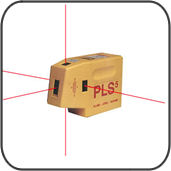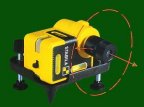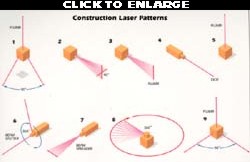
ON SITE STUD SHEAR SYSTEM

 |
ON SITE STUD SHEAR SYSTEM |
 |
There was a time, before lasers or laser levels, when the accuracy in many a well-built house was determined by a 4-ft.-long level, a plumb bob, a framing square, an 8-ft.-long folding ruler and a chalkline. It was a slower and more patient age.
 For better or worse,
today no one has the time for that stuff. Good help is hard to find, and tradespeople perpetually have their back to the wall. Often they're forced to go it alone, and quickly at that. They need accuracy, and
they need it fast. For many, the first tools they reach for are laser levels or lasers--devices with a light-emitting diode used to mark plumb, level and square. It's usually powered by a simple D, AA or AAA
battery. Laser Levels or Lasers come in any number of shapes and sizes, but their function is the same: to quickly show where you need to build.
For better or worse,
today no one has the time for that stuff. Good help is hard to find, and tradespeople perpetually have their back to the wall. Often they're forced to go it alone, and quickly at that. They need accuracy, and
they need it fast. For many, the first tools they reach for are laser levels or lasers--devices with a light-emitting diode used to mark plumb, level and square. It's usually powered by a simple D, AA or AAA
battery. Laser Levels or Lasers come in any number of shapes and sizes, but their function is the same: to quickly show where you need to build.  Where once you needed two people to snap a long chalkline or to level over long distances using a transit, now one person shoots either a point or a line of light emitted
from the laser levels or lasers. You mark where the laser hits and build there. You don't even have to bother marking. Place a piece of lumber with its edge against the laser levels line, and nail the lumber
down.
Where once you needed two people to snap a long chalkline or to level over long distances using a transit, now one person shoots either a point or a line of light emitted
from the laser levels or lasers. You mark where the laser hits and build there. You don't even have to bother marking. Place a piece of lumber with its edge against the laser levels line, and nail the lumber
down.
 1. Combination Laser Cross And Laser Square
It dosn't take long to see the incredible potential in laser levels. Some lasers have two windows. Out of one window comes two crossed lines 90° to one
another (Fig, 2). Turn the tool slightly to adjust the position of the vertical line along the horizontal line. Out of the second window comes a vertical line that is 90° from the crossed lines (Fig. 3). If
you place the tool on a surface that is within plus or minus 5° of level, the laser will level itself. If the surface is out of level more than 5°, the laser level will automatically shut itself off. The
tool can be stood anywhere, or you can mount it on a small accessory platform that slides up and down on a floor-to-ceiling pole. This gives you maximum versatility in height adjustment.
1. Combination Laser Cross And Laser Square
It dosn't take long to see the incredible potential in laser levels. Some lasers have two windows. Out of one window comes two crossed lines 90° to one
another (Fig, 2). Turn the tool slightly to adjust the position of the vertical line along the horizontal line. Out of the second window comes a vertical line that is 90° from the crossed lines (Fig. 3). If
you place the tool on a surface that is within plus or minus 5° of level, the laser will level itself. If the surface is out of level more than 5°, the laser level will automatically shut itself off. The
tool can be stood anywhere, or you can mount it on a small accessory platform that slides up and down on a floor-to-ceiling pole. This gives you maximum versatility in height adjustment.
2. Laser Level With Interchangeable Lenses For simple adaptability in laser levels, the 2-ft.-long IntelliLevel Laser Rail is hard to beat for indoor use. These levels are a 2-ft.-long aluminum bubble level that projects a laser dot from one end (Fig. 4). The tool has an accuracy of 1/4 in. at 100 ft., which is more than enough accuracy for most indoor work. You can use it alone or fasten it to a tripod. Also, two accessory lenses fit into the end of the tool. The lasers beam splitter lens projects the dot 90° relative to the tool's long axis (Fig. 6). Also, the lasers lens can be turned so that the dot can be positioned at any point within 360°. A beam spreader lens converts the dot into a line (Fig. 7).
3. Floor-Marking Laser Square About the size of a tape measure, the AccuSquare laser levels project a pair of lines along a floor. The lines are always 90° apart (Fig. 1), but their length is adjustable from 50 ft. to about 100 ft. by means of the sliding lenses on the front and side of the laser levels. One advantage of this tool, compared to chalklines or other marking methods, is that the lines can be projected over wet flooring mastic or mortar. If you slide the lenses completely to one side, the lasers project a dot instead of a line. The AccuSquare can be used by itself or it can snap onto the protractor, as shown here. Pivoting it on the protractor allows it to accurately mark angled lines through 180°
4. Combination Electronic Level And Laser Level The LaserVision X combines an electronic level laser with a dot-projecting laser (Fig. 4). As an electronic laser level, it uses an LCD window and an audio signal instead of a bubble. These lasers are accurate to plus or minus 1/8 in. at 50 ft., and a big feature is that the level and laser are both capable of being independently field calibrated for horizontal and vertical accuracy.
5. Laser Plumb Bob Modern technology and ancient technology meet in these laser levels, the Laser Plumb Bob that projects a laser point (Fig. 5). These lasers stands in a magnetically dampened base that allows it to plumb itself within seconds. It shoots a laser dot out its top. To use it as a conventional plumb, you hang it upside down. This allows the laser dot to project downward.
6. Rotary Laser Indoor/outdoor use, dot and line marking, shooting a level circle as large as 660 ft. in diameter, and marking plumb are all in a day's work for the Rotary Laser. These laser levels are equipped with a rotary head capable of projecting a laser dot in a 330-ft. radius (Fig. 8). By adjusting the head's travel, you can mark a segment of that circle. A plumb dot is projected out the top of the rotary head (Fig. 5). Finally, the Rotary Level comes with a remote sensing device that beeps when the laser beam strikes it (the dot is not visible outside)--this makes it a great tool for shooting grade over long distances in exterior excavation work or doing other jobs, such as leveling the bottom of footing trenches or setting the slope of drainage pipe. The Rotary Levels accuracy is 1/4 in. at 100 ft.
7. Pocket Laser The Tri-Lite, which is similar to the AccuSquare, is a three-beam pocket laser about the size of a tape measure. Its small size and versatility allows you to pack a lot of laser power in your toolbox or your pocket. Two dots are projected 90° apart (Fig. 9) out the front and side windows. These laser levels project a plumb dot out its top window. Notches in the base help you position it over layout lines and, because it levels itself (providing the surface is within plus or minus 4° of level), it's extremely fast to set up and use.
8. Laser Level With Angle Projector The IntelliDual Laser Level consists of a 16-in.-long, dual-bubble level with a laser mounted in its side, not its end. These laser levels project a pair of lines. You can fix the positions of the lines so they are perpendicular to one another (Fig. 2). You also can rotate the vertical line through 160° (the horizontal line remains fixed). These laser levels can be used to align sloping objects such as stair stringers and pipe. The line-sloping capability is adjustable with firmly set 15° detents. A pair of thumbscrews at each end allows you to level the tool when it is placed on an uneven surface. These lasers can also be mounted on a tripod.
9. Laser Torpedo Level It's hard to beat these LaserVision Mini laser levels. These 7-1/2-in.-long lasers are standard two-bubble torpedo levels that project a horizontal dot out one end (Fig. 4). Insert a beam splitter in the end of the tool to send the dot 90° relative to the tool (Fig. 6). The deflector rotates 360°, allowing you to mark out a line or a circumference. That's a lot of capability in a $100 tool. By the way, it also has a magnetic strip on its bottom surface that lets you quickly attach it to steel studs, pipe and other metal structures. The LaserVision Mini is accurate to 1/2 in. at 100 ft.

